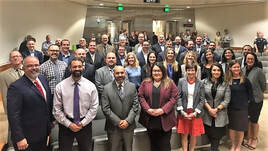Leaders in local government across San Luis Obispo County want the best for residents. That’s why the County government and local city governments have been working together with school districts and other special districts to leverage our resources to better serve residents and visitors.
In other words, local leaders are embracing regional collaboration to shape the future of SLO County.
“Local communities face many of the same social and economic challenges, and these challenges occur across multiple jurisdictions,” said County Administrative Officer Wade Horton. “We believe we can do better for the communities and people we serve by collaborating with each other instead of constantly competing.”
Most residents live their lives across multiple jurisdictions – their home may be in one community, their work might be in another, and their shopping and recreation in several others. Local leaders have recognized that collaboratively addressing the challenges our residents face in a way that leverages our resources and strengths can improve the quality of life in our communities.
Here are some of the ways we collaborated in the past year:
In other words, local leaders are embracing regional collaboration to shape the future of SLO County.
“Local communities face many of the same social and economic challenges, and these challenges occur across multiple jurisdictions,” said County Administrative Officer Wade Horton. “We believe we can do better for the communities and people we serve by collaborating with each other instead of constantly competing.”
Most residents live their lives across multiple jurisdictions – their home may be in one community, their work might be in another, and their shopping and recreation in several others. Local leaders have recognized that collaboratively addressing the challenges our residents face in a way that leverages our resources and strengths can improve the quality of life in our communities.
Here are some of the ways we collaborated in the past year:
40Prado Homeless Services Center
View this post on InstagramA post shared by County of San Luis Obispo (@countyofslo) on
Community members, local government agencies, supporters from the business and nonprofit communities joined in celebration in September 2018 when the new regional homeless services center opened at 40 Prado Road in San Luis Obispo.
The new center, known as 40Prado, consolidates homeless services under one roof. Those services include the County’s social services, drug and alcohol services, and various health services along with other private-sector services that were previously provided at the Maxine Lewis Memorial Shelter and the Prado Day Center. This project offers a cost-effective central location and sober environment for homeless families and individuals embarking on the path to self-sufficiency and personal care.
The center represents a unique collaboration from diverse community organizations and local government agencies, including the County of San Luis Obispo, SLO Chamber of Commerce, SLO Downtown Association, City of San Luis Obispo, Community Action Partnership of San Luis Obispo, Interfaith Coalition for the Homeless, People’s Kitchen, and many individual dedicated community members.
This longtime project was made possible by community support, including the single largest financial contribution to 40Prado – $500,000 – which was granted by the County Board of Supervisors in July 2018. In April 2019, the Board also approved $500,000 in Public Safety Realignment (AB109) funds to build a new withdrawal management and residential treatment center adjacent to 40Prado, which will fill a gap in care locally for those who suffer from substance abuse disorders.
40Prado currently provides a safe haven for those in need and offers a comprehensive array of services and resources to meet basic needs:
The new center, known as 40Prado, consolidates homeless services under one roof. Those services include the County’s social services, drug and alcohol services, and various health services along with other private-sector services that were previously provided at the Maxine Lewis Memorial Shelter and the Prado Day Center. This project offers a cost-effective central location and sober environment for homeless families and individuals embarking on the path to self-sufficiency and personal care.
The center represents a unique collaboration from diverse community organizations and local government agencies, including the County of San Luis Obispo, SLO Chamber of Commerce, SLO Downtown Association, City of San Luis Obispo, Community Action Partnership of San Luis Obispo, Interfaith Coalition for the Homeless, People’s Kitchen, and many individual dedicated community members.
This longtime project was made possible by community support, including the single largest financial contribution to 40Prado – $500,000 – which was granted by the County Board of Supervisors in July 2018. In April 2019, the Board also approved $500,000 in Public Safety Realignment (AB109) funds to build a new withdrawal management and residential treatment center adjacent to 40Prado, which will fill a gap in care locally for those who suffer from substance abuse disorders.
40Prado currently provides a safe haven for those in need and offers a comprehensive array of services and resources to meet basic needs:
- Housing referrals
- Job counseling and skills assessment
- Access to computer & resume/interview coaching
- Medical and rehabilitation services
- Restroom and shower facilities
- Laundry room for client use
- Local phone usage
- Lockers to store personal Items
- Voice mail and message service
- Enriching, age-appropriate activities for children
- Fenced play yard and indoor homework area for children
- Community vegetable and flower garden
- Daily meals provided by People’s Kitchen
- Bus tokens for local bus routes to essential service sites

Housing & Infrastructure
As we often hear, San Luis Obispo County is currently one of the least affordable places to buy a home in the United States. According to a report by the National Association of Home Builders, only 19 percent of families can afford to purchase the median priced home in the county.
Local non-profit affordable housing developers and other community stakeholders have identified a lack of critical infrastructure and insufficient local funding availability as some of the key obstacles to building more affordable housing in the county.
The County is coordinating a broader regional effort to examine infrastructure and housing needs countywide and to integrate efforts to address the region’s critical housing and infrastructure shortage.
A cornerstone of this effort will be the collaborative efforts between the County, seven cities, San Luis Obispo Council of Governments (SLOCOG), community stakeholders, and neighboring counties. The results of this collaborative effort will be laid out our community’s first Regional Infrastructure and Affordable Housing Strategic Action Plan.
As we often hear, San Luis Obispo County is currently one of the least affordable places to buy a home in the United States. According to a report by the National Association of Home Builders, only 19 percent of families can afford to purchase the median priced home in the county.
Local non-profit affordable housing developers and other community stakeholders have identified a lack of critical infrastructure and insufficient local funding availability as some of the key obstacles to building more affordable housing in the county.
The County is coordinating a broader regional effort to examine infrastructure and housing needs countywide and to integrate efforts to address the region’s critical housing and infrastructure shortage.
A cornerstone of this effort will be the collaborative efforts between the County, seven cities, San Luis Obispo Council of Governments (SLOCOG), community stakeholders, and neighboring counties. The results of this collaborative effort will be laid out our community’s first Regional Infrastructure and Affordable Housing Strategic Action Plan.
Stepping Up Initiative
In October 2017, the County Board of Supervisors proclaimed the County’s commitment to the nationwide Stepping Up Initiative, which focuses on reducing the number of people with mental illnesses in jails. In FY 2018-19, several local efforts and services provided worked toward this commitment.
An executive leadership team was formed that meets monthly to evaluate and recommend changes or improvements related to Stepping Up programs and services. Additionally, three staff were added to assist the Sheriff’s Office Community Action Team and the Cities of Paso Robles and Atascadero Police Departments. These staff help to divert adults with serious mental illness or co-occurring disorders from the criminal justice system to community based services.
Additionally, on December 11, 2018, the Board approved a contract with Wellpath for Jail healthcare services. Wellpath began providing services on February 1, 2019 and will begin operating a Jail Based Competency Treatment program in FY 2019-20 to treat mentally ill inmate charged with a felony that are deemed incompetent to stand trial.
The Board of Supervisors also approved a new Stepping Up Coordinator position, which will be filled in FY 2019-20. This position will help lead future efforts related to the Stepping Up Initiative.
An executive leadership team was formed that meets monthly to evaluate and recommend changes or improvements related to Stepping Up programs and services. Additionally, three staff were added to assist the Sheriff’s Office Community Action Team and the Cities of Paso Robles and Atascadero Police Departments. These staff help to divert adults with serious mental illness or co-occurring disorders from the criminal justice system to community based services.
Additionally, on December 11, 2018, the Board approved a contract with Wellpath for Jail healthcare services. Wellpath began providing services on February 1, 2019 and will begin operating a Jail Based Competency Treatment program in FY 2019-20 to treat mentally ill inmate charged with a felony that are deemed incompetent to stand trial.
The Board of Supervisors also approved a new Stepping Up Coordinator position, which will be filled in FY 2019-20. This position will help lead future efforts related to the Stepping Up Initiative.

New Animal Services Shelter
The design for a new animal services center in San Luis Obispo County continued to move forward last year. All seven cities and the County agreed to participate in the project and are working together to serve the needs of our community members and animals.
In April 2019, the County Board of Supervisors adopted the environmental review document for the new animal services facility, and authorized the issuance of a Request for Proposal to three qualified design-build entities.
Proposals were due at the end of June 2019 and a contract is anticipated to be awarded in FY 2019-20. The facility is planned for completion and occupancy in 2021.
The design for a new animal services center in San Luis Obispo County continued to move forward last year. All seven cities and the County agreed to participate in the project and are working together to serve the needs of our community members and animals.
In April 2019, the County Board of Supervisors adopted the environmental review document for the new animal services facility, and authorized the issuance of a Request for Proposal to three qualified design-build entities.
Proposals were due at the end of June 2019 and a contract is anticipated to be awarded in FY 2019-20. The facility is planned for completion and occupancy in 2021.

Central Coast Leadership Academy
Last fiscal year, 30 local leaders graduated from The Centre for Organization Effectiveness’s the Central Coast Leadership Academy.
The Centre’s Leadership Academy is the next generation program that inspires a leader to leverage the strengths they have as an individual to make a significant impact within the organization they work and in the communities they serve.
The Central Coast Leadership Academy began in October 2018 and participants graduated in April 2019. Participants of the Leadership Academy had an opportunity to complete their Certified Public Manager “CPM” Certification® a nationally recognized certification. The Centre acknowledged that 23 of the participants completed this certification and joined the ranks of 28,000 Certified Public Managers across the nation working in federal, state, and local government agencies.
Leadership Academy Capstone Projects
A distinguishing feature of this Leadership Academy is that it provides participants with an opportunity to address a significant strategic impact on their organization. This is an opportunity to demonstrate an increase in conceptual and planning skills and to showcase potential for senior leadership roles. Besides making a notable contribution to the community, several of these projects have offset the cost of the program. Capstone projects include a significant amount of thinking, preparation, study, planning, engagement, and execution.
The Capstone Projects in the Central Coast Leadership Academy were designed to address regional issues. Participants worked in diverse teams to complete regional Capstone Projects on the following topics:
Last fiscal year, 30 local leaders graduated from The Centre for Organization Effectiveness’s the Central Coast Leadership Academy.
The Centre’s Leadership Academy is the next generation program that inspires a leader to leverage the strengths they have as an individual to make a significant impact within the organization they work and in the communities they serve.
The Central Coast Leadership Academy began in October 2018 and participants graduated in April 2019. Participants of the Leadership Academy had an opportunity to complete their Certified Public Manager “CPM” Certification® a nationally recognized certification. The Centre acknowledged that 23 of the participants completed this certification and joined the ranks of 28,000 Certified Public Managers across the nation working in federal, state, and local government agencies.
Leadership Academy Capstone Projects
A distinguishing feature of this Leadership Academy is that it provides participants with an opportunity to address a significant strategic impact on their organization. This is an opportunity to demonstrate an increase in conceptual and planning skills and to showcase potential for senior leadership roles. Besides making a notable contribution to the community, several of these projects have offset the cost of the program. Capstone projects include a significant amount of thinking, preparation, study, planning, engagement, and execution.
The Capstone Projects in the Central Coast Leadership Academy were designed to address regional issues. Participants worked in diverse teams to complete regional Capstone Projects on the following topics:
- Educating Employees on Homelessness The Homelessness Education Program for public service employees is a practical, tangible, and adaptable toolkit provides guidance on how to interact with community members who are experiencing homelessness. The product encompasses three main components. The first component is a formal training program made up of local experts, the second is a resource card to provide help and direction, and the third is an educational web portal so employees have a place to go for additional information.
Formal training program: This program should be tiered towards the level of interactions an employee may have with someone experiencing homelessness. We developed a sample Tier I training program that can be used for employees with less frequent interactions (office workers, for example). This PowerPoint template was provided on a thumb drive to each municipality and can be easily tailored to fit an organization’s need.
Resource card: These are already prepared for the San Luis Obispo County. Updated cards were distributed to the San Luis Obispo County organizations attendance at the graduation 04/18/19. Santa Maria staff members are currently working on preparing a similar document for Northern Santa Barbara County. Other resource cards are available from existing organizations in our region including the Community Action Commission in Santa Barbara County, the Benefits Advocacy and Resource Connections for the Homeless in San Luis Obispo, and Home4Good
Website: The group has prepared a public employee web portal template that contains information including links to resource cards, training materials, and other information sources for public employees. This was provided on the thumb drive distributed to each organization at the graduation ceremony. - Central Coast Alliance for Cannabis Education (CACE): The legalization of cannabis in California poses new risk for Central Coast youth. Existing information and educational resources are not leveraged or effectively promoted locally. This group’s vision is to prevent under-aged cannabis use by engaging, educating, and empowering local youth to make informed and responsible decisions.
The group created a charter to form the regional coalition, Coastal Alliance for Cannabis Education (CACE), with four founding members from our respective agencies. Launching an educational campaign is anticipated to be the first action by CACE, to promote awareness of cannabis use risks to youth. From various meetings to date, the consensus from the coalition is to proceed with a customized Marijuana FactCheck website for the Central Coast region that will include an on-line toolkit of local resources. The initial Marijuana FactCheck campaign cost is $23,000. San Luis Obispo County Behavioral Health included youth cannabis education in a grant application to the State Dept. of Healthcare Services; however, have since received notice that they were not selected. As such, CACE will proceed with a funding plan to include cost-sharing among the member agencies. A Memorandum of Understanding (MOU) and agreements need to be developed to launch the campaign. - Promoting Public Employment: This group proposed the establishment of a Joint Powers Agreement (JPA) to serve as a facilitator for coordinating employment opportunities, resources, and assistance for new and current employees in the Central Coast region. They also propose a website that contains helpful information and connects the different agencies for purposes of recruitments and resources. The project is ready for a steering committee to be formed so they can vet out the formation of the JPA. The team has a draft agreement ready for review for the steering committee or any other interested agency. The project team is ready to support the steering committee in any way to help ensure continuity of the project. We are planning on continuing the team’s weekly check-in meetings to ensure materials are ready for all interested parties and to help coordinate the implementation of the project.
- Central Coast Knowledge Exchange: The Central Coast Knowledge Exchange is a program that provides agencies in the Central Coast to share resources, knowledge, and experience. Agencies can choose to participate by hosting or providing their staff an opportunity to engage in an exchange with another agency for a specified amount of time, i.e., 4 hours or 8 hours. During the exchange participants will have an opportunity to interact with the host agency creating a dynamic knowledge exchange. This group planned another knowledge exchange in June with the City of Santa Maria hosting. The group will gather the needs/requests of each agency to see what positions will be shadowed.


